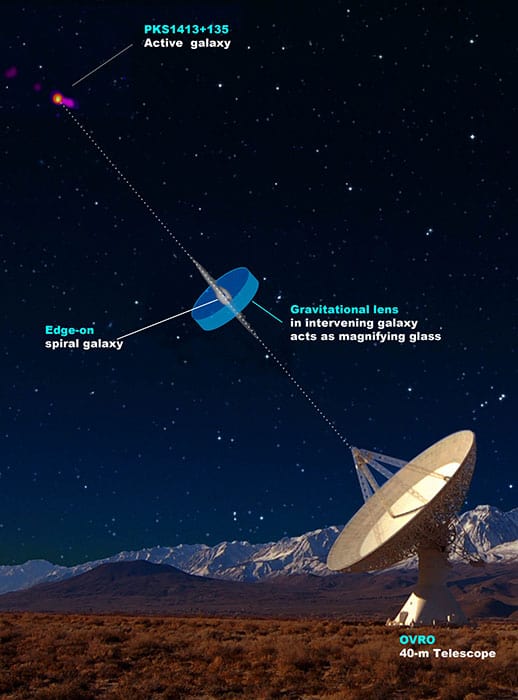
A new type of gravitational lens could allow astronomers to probe dark matter as well as matter a million times the mass of the Sun. Harish Vedantham of Caltech’s Owens Valley Radio Observatory in the US and colleagues identified the lens at radio wavelengths, and they suggest it is magnifying light from clumps of matter racing relativistically along jets that are blasting from a galaxy’s central supermassive black hole.
Vedantham and team discovered the lens within a survey of 1800 active galaxies, which has been ongoing since 2008. The team focused on an active galaxy called PKS 1413+135, located about three billion light-years away and which mysteriously brightened, first in 2009 and then again in 2014. Something between us and the galaxy, with a mass equivalent to 10,000 suns, is warping space into a cosmic magnifying glass.
A new approach to finding lenses
Gravitational lensing occurs when the large mass of an object bends space to such a degree that it magnifies the light of more distant objects, and even creates multiple distorted images of those background objects. On large scales, galaxy clusters regularly act as lenses for more distant galaxies. On much smaller scales, exoplanets have been spotted briefly magnifying the light of background stars in cases of gravitational “micro-lenses”.
On the other hand, gravitational “milli-lensing” falls between the two extremes, where objects smaller than galaxies but more massive than individual stars or planets form the lenses, but they are so hard to spot that none had been found until now.
The multiple images a milli-lens creates are spaced so narrowly that they are at the limit of our current telescopic sensitivity. Instead Vedantham’s team has adopted what he describes as “a new approach to finding and studying milli-lenses”. Instead of looking for multiply lensed images, they searched for signs of what they call “symmetric achromatic variability” – the symmetrical brightening and fading of radio emission from an object that is passing precisely behind the lens for about a year. Vedantham’s team suggest that the milli-lens magnified the light from two clumps of searingly hot plasma – one in 2009, the other in 2014 – that were moving along jets blasting out from PKS 1413+135’s central black hole.
Mystery magnifier
The real mystery is the identity of the object acting as the lens. A large star cluster could do the trick, although there are no obvious intervening foreground galaxies where such a cluster could reside, meaning it would have to be within a faint dwarf galaxy that has yet to be discovered. Alternatively, it could be an intermediate mass black hole, perhaps one that was made just after the Big Bang.
“A black hole always fits the bill,” says Vedantham. If it is a black hole, then it is possible it is a member of a large population of primordial black holes that wander alone through space and could account for a significant fraction of dark matter (see our earlier story).
Even if the lensing object is something more mundane like a star cluster, it could still be used to probe dark matter. “Different dark-matter theories make different predictions about structure formation in the universe,” says Vedantham. Therefore, the nature of dark matter can have repercussions for the relative numbers of clumps of matter at different scales, from galaxy clusters to individual galaxies to star clusters and giant molecular clouds. “By observing the abundance of galaxies of different mass we have put these theories to the test, but the lower mass range has always been out of reach,” he says.
To Vedantham’s mind, gravitational milli-lensing is the only “realistic” way of probing matter in this lower mass range, and if more milli-lenses can be discovered they could help define our models of dark matter. Already Vedantham believes his team has identified a second milli-lens, seen by the University of Michigan Radio Astronomy Observatory in the active galaxy AO 0235+164, which displayed variability in 1994 and 1999 across a wide range of wavelengths (hence the phenomenon being described as achromatic). It is hoped that sophisticated “very-long-baseline interferometry” (VLBI) techniques could soon have the resolution to detect the multiple images of milli-lenses and provide another way of discovering them.
The research is published in The Astrophysical Journal.



